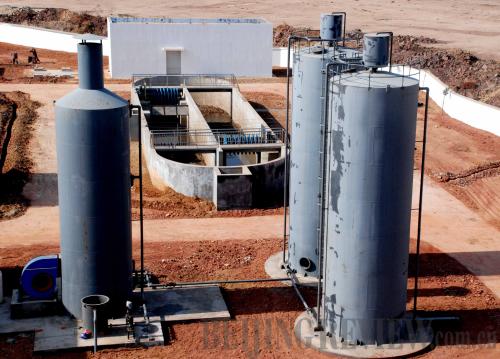|
 |
|
CLEANING UP: A wastewater treatment plant in Wuyuan County, Jiangxi Province was put into operation on November 28, 2007. The plant can treat 120 tons of wastewater daily (WANG GUOHONG) |
Few Beijingers who are enjoying the bustle of modern city life realize that they are being besieged by trash. If no measures were taken, Beijing would soon see itself in the middle of a garbage crisis, said Chen Yong, head of the Beijing Municipal Cityscape Management Commission. The volume of trash the city produces grows 8 percent annually. Officials project that more than 12 million tons of trash will be generated in Beijing each year by 2015.
Researchers using remote-sensing technology in 1983 found that landfills were scattered between Beijing's Third and Fourth Ring roads. More than 4,700 of the dumps were larger than 50 square meters. The Beijing Municipal Government had invested 2.3 billion yuan ($338 million) to build waste treatment facilities to solve the problem.
"Waste management requires science and technology for improvement," said Wu Wenwei, head of the Beijing Environmental Sanitation Engineering Research Institute. Wu said waste treatment technologies are progressing in two directions—researching commonly used landfill, incineration and compost technologies to reduce pollution, lower costs and increase recovery rates and developing other new methods to deal with trash.
"The optimal solution is to produce little or no waste. The sub-optimal solution is to recover waste, and the third best option is to build waste treatment plants and strive to treat 100 percent of waste," said Wang Weiping, a senior engineer at the Beijing Municipal Cityscape Management Commission and a consultant to the Beijing Municipal Government. Wang, who has spent more than 20 years researching garbage, is one of many experts pushing for a fully circular economy.
In recent years, Beijing has actively promoted waste reduction, reuse and recycling, as well as scientific waste treatment. The city has constructed a number of key facilities for waste collection, transportation and disposal, and is gradually building a multidimensional waste treatment system, said Yang Zhihui, Director of the Environment and Resource Section of the Beijing Municipal Development and Reform Commission.
Recycle
Beijing has been building large landfills and other treatment facilities since 1992.
"Beijing's landfills are constructed according to national standards, with seepage control, leach ate collection and removal and bio gas collection systems. The landfill techniques are very complicated, and there are strict and clear technical specifications," said Wu. Every layer of waste, about 1 meter thick, is regularly sanitized, deodorized and covered with a layer of soil. The bottoms of landfills are covered with thick polyethylene films to prevent leakage and to protect groundwater and soil from contamination. Thick, black pipes dot the surface of the landfills and are used to collect bio gas from waste.
|
